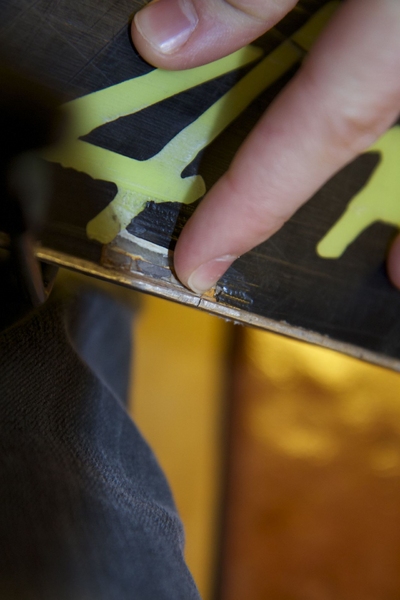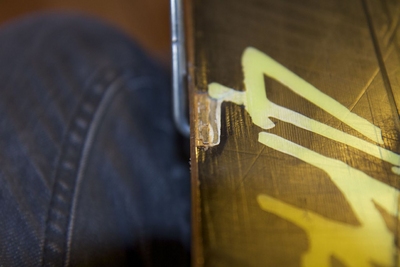A quick word on blocking ads

It looks like you are using an ad blocker. That's okay. Who doesn't? But without advertising revenue, we can't keep making this site awesome. Click the link below for instructions on disabling adblock.
Welcome to the Newschoolers forums! You may read the forums as a guest, however you must be a registered member to post. Register to become a member today!
Take your boot out, grab the toe piece, try to rock it back and forth along the length of your ski.
If it moves significantly, they're stuffed, if they're older Jesters particularly they're prone to the peg/pylon that supports the top half of the toe piece becoming loose in the hole in the base plate bit that screws to the ski.
If not, forward pressure problem.
Ahh, excuse my slang... stuffed = damaged, worn, faulty.
Whether you can still ski them depends how loose the toe pylon is. When it's just a little bit loose, all that really happens is they make a lot of clicking noises as your boot toe bounces up and down in the gap. Also force transmission is not great.
When they get really worn, if you land heavily on the tail of your skis the toe piece will roll forward enough that your boot can come out vertically. Once this starts happening the bindings quickly get much worse as this motion is very bad for the assembly that holds the toe pylon into the base plate.
Old Jesters don't have toe height adjustment, only the new ones do.
And his are suffering from a fault that many of the old ones have, where the toe pylon gets loose in the base plate and is able to rock forward creating a gap.
Usual disclaimer applies here: Asking the internet about binding adjustment will result in your legs turning into spaghetti with your blood as the bolognaise sauce...
Aside from that, it shouldn't change the actual release force at all. I use a business card to check the toe height - click the boot in, pull back hard on the cuff so the top side of the toe lug on the boot is against the underside of the binding wings. There should be just enough room between the AFD and the flat bit on your boot for the business card to slide smoothly in and out. Some people like them set up a little more aggressively, where the business card will catch slightly on the way through. Personal choice really, it's a trade-off between slightly better power transmission and a slightly worse release.
Buuuuut before you get too carried away, check the forward pressure is correct too.
JakeSmithI need help compiling a sort of shopping list for what I need for waxing and tuning. I don't really ski that much park at all. I haven't touched a rail in a year or two.
Skis are Liberty Morphics with a ptex 2000 base and Surface One Lifes with extruded base. Dad's skis are Nordica Steadfast with sintered base (wont be tuning these, just waxing as they are season demos)
Liberty's have a core shot in them and I plan on getting a ski specific soldering iron for base welds. So I probably wont use PTex candles for any base repair unless I am traveling.
Here is what I am thinking so far
1) Iron
2) All temp wax
3) Rub on wax
4) Brushes but don't know what kinds
5) Plastic scraper
6) Gummy stone
7) Metal Scraper
Do I really need to get edge sharpening stuff? Would just a Dakine Edge tuner or something of the like work or should I get a base beveler? What are files and stones for?
jcos1232about bindings if i have 93mm waist skis and am looking at a 90mm binding will it bend to work properly?
ec_jibberWill I be able to mount a pair of fks 140s on a ski that was previously mounted on sth 12s? Will the old holes interfere with the new ones?
rozboonYou will need to remount in a different position. The mounting patterns of those 2 bindings conflict horribly, the front 2 holes of the STH heel are in pretty much the exact same place length-wise as the rear 2 on the FKS, but a different width. Likewise the rear holes of the toepiece. So if it's drilled for centre, and you still want to be at centre, you're gonna have trouble.
Grilled.SteezeKinda lazy to read through this whole thread right now, but I have a quick question. How important is it to use a specific iron for waxing? Is it one of those things that only try hards do or is it actually necessary?
rozboonShort answer: At the end of the day all you're doing is melting wax onto a bit of plastic then spreading it around. It's not rocket science, anything fairly hot will work.
Long answer: Most normal irons use a very coarse thermostat to control the temperature. If you graphed the temperature of the base it would look a bit like this /\/\/\/\ with the hottest point being realistically far hotter than you want for waxing skis - it's above the smoke point of the wax a lot of the time, and it is hot enough to damage the base and epoxies in your skis if you're not quick with it.
A proper waxing iron uses more complex temperature control, to maintain a lower, even temperature.
The other issue is that a normal iron has holes in the bottom, which will wick up the wax so it doesn't spread as nicely. A waxing iron usually has a solid base that is either smooth or lightly grooved to carry the wax better.
All that said, I know loads of people who've done their waxing for years with a $2 iron from a thrift shop. It's just somewhat easier with a dedicated waxing iron.



BikerjeffI have just gotten armada halo 2's mounted at -5 (factory recomended) and I was thinking its a bit to far back. I'm looking to ski 35% park and 65% all mtn/pow. I have bindings that slide so you can adjust for bigger boots. Do you think I could slide my bindings up to -2.5 without messing up my entire binding setup?
Thanks
_Jeffrey_So i have a pair of look px 12 bindings... i unscrewed them, only to find out to put them back on the screw holes from the brake and baseplate don't line up. Is there a trick to this? i can get them to line up but the brake won't be flush with the base plate. If anyone understands this please help me out